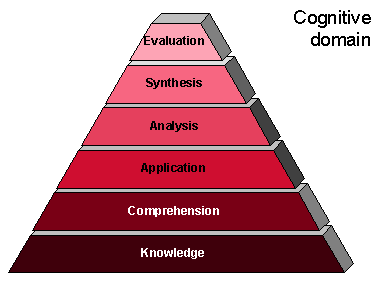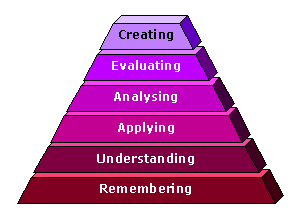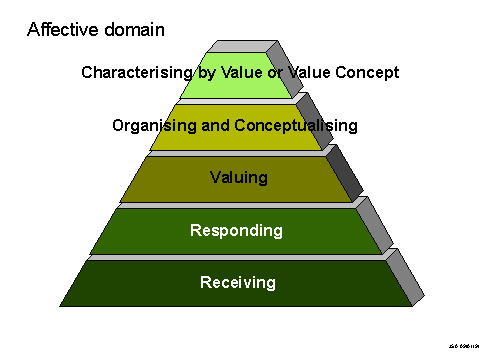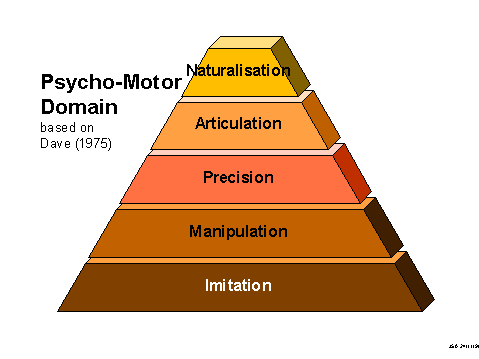"Taxonomy” simply means “classification”, so the well-known taxonomy of learning objectives is an attempt (within the behavioural paradigm) to classify forms and levels of learning. It identifies three “domains” of learning (see below), each of which is organised as a series of levels or pre-requisites. It is suggested that one cannot effectively — or ought not try to — address higher levels until those below them have been covered (it is thus effectively serial in structure). As well as providing a basic sequential model for dealing with topics in the curriculum, it also suggests a way of categorising levels of learning, in terms of the expected ceiling for a given programme. Thus in the Cognitive domain, training for technicians may cover knowledge, comprehension and application, but not concern itself with analysis and above, whereas full professional training may be expected to include this and synthesis and evaluation as well.
- Cognitive: the most-used of the domains, refers to knowledge structures (although sheer “knowing the facts” is its bottom level). It can be viewed as a sequence of progressive contextualisation of the material. (Based on Bloom, 1956)

The model above is included because it is still common currency, but Anderson and Krathwohl (2001) have made some apparently minor but actually significant modifications, to come up with:

Revised taxonomy of the cognitive domain
following Anderson and Krathwohl (2001)
Note the new top category, which is about being able to create new knowledge within the domain, and the move from nouns to verbs.
In higher education, "understand" is still—in my view—problematic in its positioning. There is a higher, contextualised level of "understanding" which comes only with attempting to evaluate ideas and to try them out in new ways, or to "create" with them. It is what I expect at Master's level. The taxonomy is an epistemological rather than psychological hierarchy, but it also has a basic chronological element: you achieve certain levels before others. This higher, Gestalt, level of understanding comes last, in my experience: my principal evidence is in the use of research methods. The "real", intuitive, contextualised, critical, strategic understanding only happens when you have tried to be creative within the field... Argue with me (use the "comments welcome" link below). And thanks to all the people who have done so; I hope you found it a useful activity. I did! See more notes at the bottom of the page arising from those discussions.
Apologies to the reader who prefers "Analyzing"!
- Affective: the Affective domain has received less attention, and is less intuitive than the Cognitive. It is concerned with values, or more precisely perhaps with perception of value issues, and ranges from mere awareness (Receiving), through to being able to distinguish implicit values through analysis. (Kratwohl, Bloom and Masia (1964))

- Psycho-Motor: Bloom never completed work on this domain, and there have been several attempts to complete it. One of the simplest versions has been suggested by Dave (1975): it fits with the model of developing skill put forward by Reynolds (1965), and it also draws attention to the fundamental role of imitation in skill acquisition.

This page is also available in Slovak from Everycloudtech - http://www.everycloudtech.com/bloomova-taxon%C3%B3mia
This is an archived copy of Atherton J S (2013) Learning and Teaching [On-line: UK] Original material by James Atherton: last up-dated overall 10 February 2013

This work is licensed under a Creative Commons Attribution-Noncommercial-No Derivative Works 3.0 Unported License.
"This site is independent and self-funded, although the contribution of the Higher Education Academy to its development via the award of a National Teaching Fellowship, in 2004 has been greatly appreciated."

